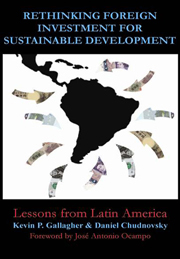Book contents
- Frontmatter
- Contents
- List of Figures
- List of Tables
- Foreword
- Acknowledgements
- Author Biographies
- Rethinking Foreign Investment for Sustainable Development
- 1 FDI and Sustainable Development in the Americas
- 2 Is Foreign Investment Always Good for Development?
- Part 1 Country Assessments
- 3 Islands of Possibility: MNCs and Economic Development in Brazil
- 4 Foreign Investment: The Polarization of the Mexican Economy
- 5 A Missed Opportunity: Foreign Investment and Sustainable Development in Argentina
- 6 Foreign Investment and Economic Development in Costa Rica: The Unrealized Potential
- Part 2 Political Economy of Natural Resources and The Environment
- Notes
- References
- Index
4 - Foreign Investment: The Polarization of the Mexican Economy
from Part 1 - Country Assessments
Published online by Cambridge University Press: 05 March 2012
- Frontmatter
- Contents
- List of Figures
- List of Tables
- Foreword
- Acknowledgements
- Author Biographies
- Rethinking Foreign Investment for Sustainable Development
- 1 FDI and Sustainable Development in the Americas
- 2 Is Foreign Investment Always Good for Development?
- Part 1 Country Assessments
- 3 Islands of Possibility: MNCs and Economic Development in Brazil
- 4 Foreign Investment: The Polarization of the Mexican Economy
- 5 A Missed Opportunity: Foreign Investment and Sustainable Development in Argentina
- 6 Foreign Investment and Economic Development in Costa Rica: The Unrealized Potential
- Part 2 Political Economy of Natural Resources and The Environment
- Notes
- References
- Index
Summary
In the 1990s Mexico was one of the world's most successful countries in attracting FDI. This chapter examines the extent of this process and its effects on the Mexican economy. I provide an overview of Mexican FDI since the early 1990s, identify the factors that led to FDI inflows, and describe the effects of FDI in terms of output, employment, trade and R&D expenditures, among other variables. Specifically, I analyze these effects using newly available data on the industry level. Finally, I make several policy proposals aimed at improving both the quantity and quality of FDI in the future.
The chapter is divided into four sections. The first briefly outlines theories of FDI and development, including an overview of the literature on the impacts of FDI in Mexico. The second section highlights the main trends in Mexican FDI since the 1990s from an aggregate perspective, as well as some major sectoral tendencies. The third section analyzes the effects of FDI in Mexico's manufacturing sector at the industry level, considering more than 25 variables. The final section outlines the main conclusions and presents various policy proposals.
Brief Conceptual Background
The debate on the determinants of FDI and its effects is still unsettled. The current process of globalization—the opening of national economies, the growing role played by multinational corporations and the increasing transfer of segments of the production chain outside these corporations' home countries-has promoted the growth of global FDI flows (UNCTAD 2006).
- Type
- Chapter
- Information
- Rethinking Foreign Investment for Sustainable DevelopmentLessons from Latin America, pp. 51 - 76Publisher: Anthem PressPrint publication year: 2009



